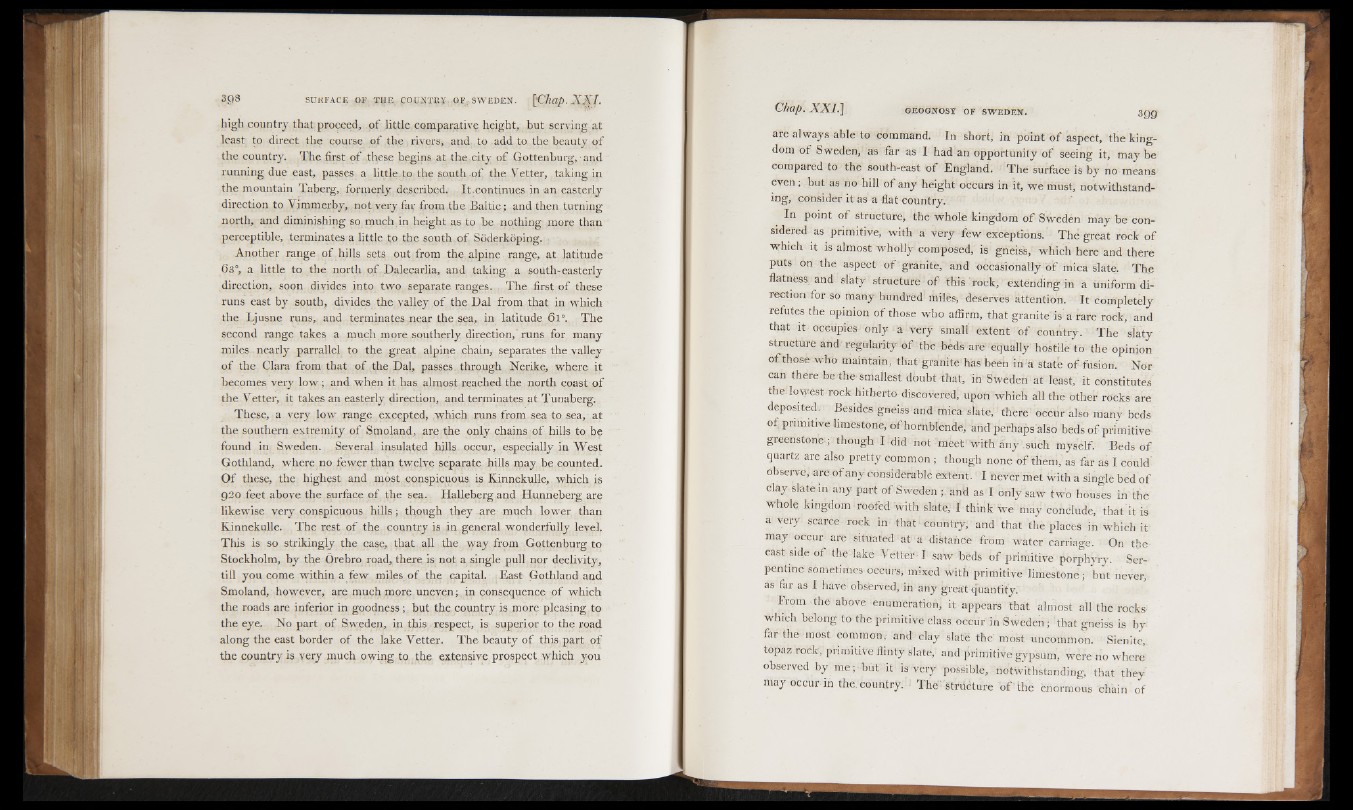
high country that proceed, of little comparative height, but serving at
least to direct the course of the; rivers, and to add to the beauty of
the country. The first of these begins at the,city of Gottenburg, and
running due east, passes a little.to the south of the Vetter, taking in
the mountain Taberg, formerly, described. It.continues in an easterly
direction to Vimmerby, not very far from the Baltic; and then turning
north, and diminishing so much in height as to be nothing more than
perceptible, terminates a little to the south of. Soderkoping.
Another range of hills sets out from the alpine range, at latitude
63°, a little to the north of Dalecarlia, and taking a south-easterly
direction, soon divides into two separate ranges. The first o f these
runs east by south, divides the valley ,of the Dal from that in which
the Ljusne runs, and terminates near the sea, in latitude 61°. The
second range takes a much more southerly direction, runs for many
miles nearly parrallel to the great alpine chain, separates the valley
of the Clara from that o f the Da], passes, through Nerike, where it
becomes very low; and when it has almost reached the north coast of
the Vetter, it takes an easterly direction, and terminates at Tunaberg.
These, a very low range excepted, which runs from sea to sea, at
the southern extremity of Smoland, are the only chains o f hills to be
found in Sweden. Several insulated hills occur, especially in ^Vest
Gothland, where no fewer than twelve separate hills may he counted.
Of these, the highest and most, conspicuous is Kinnekulle, which is
920 feet above thefsurface of the sea. Halleherg and Hunneberg are
likewise very conspicuous hills; though they are much lower, than
Kinnekulle. The rest of the country is in general wonderfully level.
This is so strikingly the case, that all the way from Gottenburg to
Stockholm, by the Örebro road, there is not a single pull nor declivity,
till you come within a few miles, of the capital. East Gothland and
Smoland, however, are much more uneven; in consequence o f which
the roads are inferior in goodness; but the country ismore pleasing to
the eye. No part of Sweden, in this respect, is superior to the road
along the east border of the lake Vetter. The beauty of this part of
the country is very much owing to the extensive prospect which you
are always able to command. In short, in point o f aspect, the kingdom
o f Sweden, as far as I had an opportunity of seeing it, may be
compared to the south-east o f England. Thé surface is by no means
even ; but as no hill of any height occurs in it, we must, notwithstanding,
consider it as a flat country.
In point of structure, the whole kingdom o f Sweden may be considered
as primitive, with a very few exceptions. Thè great rock of
which it is almost whollÿ composed, is gneiss, which here and there
puts on the aspect o f granite, and occasionally of mica slate. The
flatness and stety ' structuré- o f this rock, extending in a uniform direction
for so many hundred mil'ès, deserves attention. It completely
refutes the opinion o f those who affirm, that granite'is a rare rock, and
that it-occupies only a very small extent o f country. The slaty
structure and regularity o f the béds ;aré’!éi]üà]ly hostile to the opinion
o f those who maintain, that granite'has bceh in a state o f fusion. Nor
can there be the smallest doubt that, in Sweden at least, it constitutes
the. lowest, rock hitherto discovered/upon which all the other rOcks are
deposited. Besides gneiss and mica'slate,’ there occur also many beds
of primitive limestone, of hornblende, and perhaps also beds o f primitive
greenstone / though I did not meet’ with any such myself. Beds of
quartz are also pretty common ; though none Of them, as far as I could
observe,' nreo f any Considerable extent. I héver met with a single bed of
clay, slate in any part ofSweden ;. and as I onlysaw two houses in the
whole kingdom , roofed With slate, I think We may conclude, that it is
a very: scarce - rock in' that-country,'and that the placés in which it
may occur arp situated at a distance from water carriage. On the
east side of the-'lake ¥etter: B saw beds o f primitive porphyry. Serpentine
sometimes occurs* mixèd With primitive limestone; but never,
as far as I have observed, in any gréât quantify.
From the above enumeration, it appears that almost all the rocks
which belong to the primitive class occur in Sweden ; that gneiss is by
far the most common, and clay slate the most uncommon. Sienite,
topaz rock, primitive flinty slate, and primitive gypsum, were no where
observed by me ; -but 'it is very possible, notwithstanding, that they
may occur in the. country.: - ThmstrÜdture o f ’ the enormous chain of